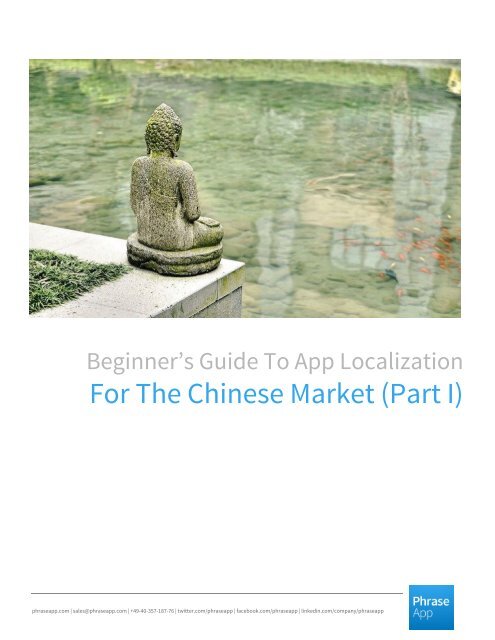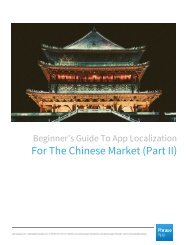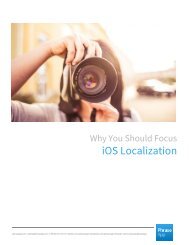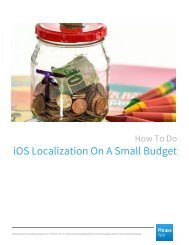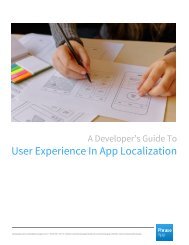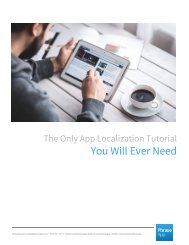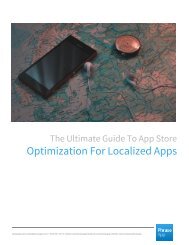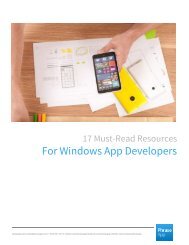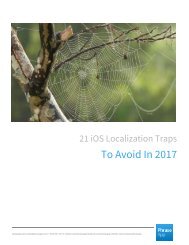Beginner’s Guide To App Localization For The Chinese Market (Part 1)
You also want an ePaper? Increase the reach of your titles
YUMPU automatically turns print PDFs into web optimized ePapers that Google loves.
<strong>Beginner’s</strong> <strong>Guide</strong> <strong>To</strong> <strong>App</strong> <strong>Localization</strong><br />
<strong>For</strong> <strong>The</strong> <strong>Chinese</strong> <strong>Market</strong> (<strong>Part</strong> I)<br />
phraseapp.com | sales@phraseapp.com | +49-40-357-187-76 | twitter.com/phraseapp | facebook.com/phraseapp | linkedin.com/company/phraseapp
<strong>Beginner’s</strong> <strong>Guide</strong> <strong>To</strong> <strong>App</strong> <strong>Localization</strong> <strong>For</strong> <strong>The</strong> <strong>Chinese</strong> <strong>Market</strong>tion (<strong>Part</strong> I)<br />
Table of Content<br />
1. IOS Or Android? What <strong>The</strong> Numbers Tell Us 4<br />
2. Localize Efficiently: Is Your <strong>App</strong> Suitable <strong>For</strong> <strong>The</strong> <strong>Chinese</strong> <strong>App</strong> <strong>Market</strong>? 6<br />
3. First Step In <strong>App</strong> <strong>Localization</strong> <strong>For</strong> China: Get Ready <strong>For</strong> New Rules 6<br />
4. Pay Attention <strong>To</strong> Translation: <strong>Chinese</strong> Is Tricky 8<br />
5. <strong>Localization</strong> Details <strong>For</strong> <strong>The</strong> <strong>Chinese</strong> <strong>Market</strong> 9<br />
When Working On Your <strong>App</strong> Layout And Design, You’ll Need <strong>To</strong> Consider That: 10<br />
Don’t <strong>For</strong>get Any Locale Specifics When Going Through <strong>The</strong> <strong>Localization</strong> Process: 10<br />
phraseapp.com | sales@phraseapp.com | +49-40-357-187-76 | twitter.com/phraseapp | facebook.com/phraseapp | linkedin.com/company/phraseapp
<strong>Beginner’s</strong> <strong>Guide</strong> <strong>To</strong> <strong>App</strong> <strong>Localization</strong> <strong>For</strong> <strong>The</strong> <strong>Chinese</strong> <strong>Market</strong>tion (<strong>Part</strong> I)<br />
<strong>App</strong> localization is on everyone’s to-do list for 2017. Why? Because it’s increasingly proven itself<br />
as an effective way of gaining market share and sales globally. No matter where your app<br />
localization starts, get it right for the <strong>Chinese</strong> market and you’ll hit the jackpot.<br />
China’s been top of the list for the number of smartphone users worldwide since 2013. But it’s<br />
now the world’s biggest app market. We’re talking about revenues of over $25 billion in 2016,<br />
estimated to reach $42 billion by 2020!<br />
Yep, China pretty much has it all. Not least, a large (and still growing) number of smartphone<br />
users (1.3 billion) willing to buy your app. <strong>Chinese</strong> users spend five times more than they used<br />
to two years ago, and have an insatiable appetite for technology and gadgets.<br />
Sounds too good to be true? Well, maybe because it is. Sorry to tell you this, but there’s a long<br />
road between your app and the <strong>Chinese</strong> app stores. <strong>App</strong> localization for China is anything but<br />
easy. You need to adapt your app to a completely different customer, who has little or nothing<br />
in common with your current users.<br />
<strong>The</strong>n you’ll have to redesign for a different culture, respect local legislation, translate<br />
everything into <strong>Chinese</strong> and cleverly market your app. How do you do that? Check out our<br />
beginner’s guide to app localization for the <strong>Chinese</strong> market.<br />
phraseapp.com | sales@phraseapp.com | +49-40-357-187-76 | twitter.com/phraseapp | facebook.com/phraseapp | linkedin.com/company/phraseapp
<strong>Beginner’s</strong> <strong>Guide</strong> <strong>To</strong> <strong>App</strong> <strong>Localization</strong> <strong>For</strong> <strong>The</strong> <strong>Chinese</strong> <strong>Market</strong>tion (<strong>Part</strong> I)<br />
1. IOS Or Android? What <strong>The</strong> Numbers Tell Us<br />
Whether you’re an app developer or product manager, you know by now that iOS and Android<br />
were not created equal. When it comes to the number of smartphone users and their buying<br />
behavior, the difference is clear. And in China, the app market looks quite different from the<br />
West.<br />
In 2016, less than a quarter of <strong>Chinese</strong> smartphone users used the iOS operating system.<br />
However, <strong>App</strong>le fans in China are generally loyal to the brand, which gives a consistent<br />
audience for iOS apps. Entering the <strong>Chinese</strong> app market using the iOS <strong>App</strong> Store is easier, as<br />
rules regarding ASO and ranking are the same all over the world.<br />
phraseapp.com | sales@phraseapp.com | +49-40-357-187-76 | twitter.com/phraseapp | facebook.com/phraseapp | linkedin.com/company/phraseapp
<strong>Beginner’s</strong> <strong>Guide</strong> <strong>To</strong> <strong>App</strong> <strong>Localization</strong> <strong>For</strong> <strong>The</strong> <strong>Chinese</strong> <strong>Market</strong>tion (<strong>Part</strong> I)<br />
In China, <strong>App</strong>le managed to consolidate its position, making it the number two country for iOS<br />
app spending, after the US, in 2015, with revenues over $3 billion. In 2016, China overtook the<br />
US by more than 15%.<br />
Android, on the other hand, dominates the local market, but comes with many challenges for a<br />
non-<strong>Chinese</strong> app developer. It’s no secret that Google can’t keep a constant presence in the<br />
<strong>Chinese</strong> market. In terms of apps, this situation translates into a long absence of Google Play<br />
and over 200 local app stores, each with its own regulations.<br />
If you want to localize your Android app for China, you’ll have to negotiate with each store<br />
individually. That means getting an app certification for each one and putting your app through<br />
the entire QA process every time you release in a new store.<br />
<strong>The</strong> most popular app stores for Android in China are:<br />
● Tencent Myapp <strong>App</strong> Store, owned by China’s social media giant Tencent<br />
● 360 Mobile Assistant, with over 275 million active users<br />
● Baidu Mobile Assistant, used by 16% of all app users in China<br />
Besides the third-party app stores, China has a series of manufacturer stores where you can sell<br />
your app. <strong>The</strong>se include Xiaomi <strong>App</strong> Store or Huawei <strong>App</strong> Store, and a few carrier stores, like<br />
China Unicom WoStore and China Telecom Tianyi Store.<br />
Entering the <strong>Chinese</strong> market with iOS and Android versions of your app at the same time is<br />
expensive and rarely efficient. So, you should prioritize the one that will help you achieve better<br />
results. <strong>App</strong>le users tend to spend more for apps than Android users, so if your target pays for<br />
premium accounts, choosing iOS over Android could be the right path to follow.<br />
you’ll have to integrate different billing SDK every time you list your app in a new store that<br />
doesn’t accept Alipay.<br />
phraseapp.com | sales@phraseapp.com | +49-40-357-187-76 | twitter.com/phraseapp | facebook.com/phraseapp | linkedin.com/company/phraseapp
<strong>Beginner’s</strong> <strong>Guide</strong> <strong>To</strong> <strong>App</strong> <strong>Localization</strong> <strong>For</strong> <strong>The</strong> <strong>Chinese</strong> <strong>Market</strong>tion (<strong>Part</strong> I)<br />
2. Localize Efficiently: Is Your <strong>App</strong> Suitable <strong>For</strong> <strong>The</strong><br />
<strong>Chinese</strong> <strong>App</strong> <strong>Market</strong>?<br />
In 2015, one in four <strong>Chinese</strong> smartphone users installed foreign apps, according to TalkingData.<br />
This means more than three million smartphones in China had at least one foreign application<br />
in 2015. While the numbers have been growing since then, local apps still dominate the <strong>Chinese</strong><br />
app market.<br />
No matter how successful your app is in the West, it can fly under the radar of <strong>Chinese</strong> users.<br />
Get prepared to enter a new market, where everything is different. From pricing strategies, to<br />
business models and buying habits. Knowing if you have a chance to sell in a place where<br />
people have different interests from your current customers is essential. Especially if you’re<br />
looking for profits and global success.<br />
<strong>The</strong> most popular <strong>Chinese</strong> apps are used for instant messaging and communication,<br />
entertainment (games, videos and music), and browsing the internet. No foreign app that<br />
provides social network services has been successful in this country so far. When it comes to<br />
foreign apps, <strong>Chinese</strong> users prefer games, online shopping, videos, photography, education<br />
and finance.<br />
In recent years, almost all users have shown a special interest for games. iOS users are more<br />
willing to install apps for fashion, online shopping, radio and music. While Android users are<br />
generally more interested in watching videos, taking photos and using navigation apps.<br />
Education and finance apps are also slightly more popular among Android users.<br />
But, the <strong>Chinese</strong> app market is dynamic. What’s hot today can easily become history in just a<br />
few months. <strong>App</strong>s in China have an average life cycle of just 10 months and around 85% of users<br />
delete an app less than thirty days after downloading it.<br />
It’s tough out there, so make sure that you’re ready to go the distance with your app<br />
localization project. Localize only if there’s a real interest in your app in the <strong>Chinese</strong> market.<br />
Ask yourself if you can keep up with the trends and – most importantly – if you can find enough<br />
room among local developers.<br />
phraseapp.com | sales@phraseapp.com | +49-40-357-187-76 | twitter.com/phraseapp | facebook.com/phraseapp | linkedin.com/company/phraseapp
<strong>Beginner’s</strong> <strong>Guide</strong> <strong>To</strong> <strong>App</strong> <strong>Localization</strong> <strong>For</strong> <strong>The</strong> <strong>Chinese</strong> <strong>Market</strong>tion (<strong>Part</strong> I)<br />
3. First Step In <strong>App</strong> <strong>Localization</strong> <strong>For</strong> China: Get Ready<br />
<strong>For</strong> New Rules<br />
<strong>App</strong> localization for the <strong>Chinese</strong> is different from anything you’ve done before! Not just because<br />
you’re going to see your app in a language you don’t understand, but because there’s a series<br />
of technical details you need to factor in to fit in the local market.<br />
You can encode with any of the following standards: EUC-CN, ISO-2022-CN,<br />
ISO-2022-CN-extension, or GBK. But, it’s wiser if you use Unicode (UTF-8), which supports all<br />
<strong>Chinese</strong> characters and allows for multiple language localization in the future.<br />
It’s also essential to find a local server to host your app and to integrate your app to<br />
<strong>Chinese</strong>-based cloud systems. Otherwise, your clients will have difficulties accessing your<br />
services – think delays and disconnections. You’ll have access to <strong>Chinese</strong> servers only if you<br />
have a local partner or legal entity in China.<br />
If you’re not ready to go that way, you can use servers in Hong Kong, Indonesia, Malaysia,<br />
Philippines, or Singapore. Servers in Europe or North America are generally not recommended.<br />
China’s Great Firewall is one of the biggest challenges for any foreign app developer, so having<br />
a local partner can considerably increase your chances of success.<br />
phraseapp.com | sales@phraseapp.com | +49-40-357-187-76 | twitter.com/phraseapp | facebook.com/phraseapp | linkedin.com/company/phraseapp
<strong>Beginner’s</strong> <strong>Guide</strong> <strong>To</strong> <strong>App</strong> <strong>Localization</strong> <strong>For</strong> <strong>The</strong> <strong>Chinese</strong> <strong>Market</strong>tion (<strong>Part</strong> I)<br />
4. Pay Attention <strong>To</strong> Translation: <strong>Chinese</strong> Is Tricky<br />
One of the most important steps in the app localization process is translation. As many <strong>Chinese</strong><br />
translators don’t have in-depth knowledge of Western ways of talking, you should look for a<br />
diverse team. Try to include locals and native speakers living outside of China.<br />
This way, you’ll make sure your message is translated correctly, respecting local syntax and<br />
terminology, and staying in keeping with your global brand. Give your translators details about<br />
your app, as they need context to come up with an accurate translation.<br />
When localizing for China, it’s impossible to deliver a high-quality product using automated<br />
translation. So, don’t try to save money by using Google Translate or any other similar<br />
software. <strong>Chinese</strong> people like complex expressions and have different expectations when it<br />
comes to writing styles. You need human translation to make sure your messages are<br />
appropriate for the target audience.<br />
Translate all content, from titles, descriptions, texts inside images, error messages and<br />
feedback requests. Don’t leave anything out, or your app will be instantly deleted. If you’re not<br />
sure which <strong>Chinese</strong> language to choose for your translation, you should know that Mandarin<br />
and Cantonese are spoken languages and have nothing to do with your written content.<br />
<strong>The</strong> only case where you’d need to decide on using one or the other is if you include voice<br />
messages in your app. In this case, you should probably opt for Mandarin, as it’s the official<br />
language in both China and Taiwan.<br />
<strong>Chinese</strong> has two writing systems, though. Simplified <strong>Chinese</strong> is used in China and Singapore,<br />
while Traditional <strong>Chinese</strong> is used in Hong Kong and Taiwan. Depending on your target market,<br />
you’ll need to choose one system over another.<br />
phraseapp.com | sales@phraseapp.com | +49-40-357-187-76 | twitter.com/phraseapp | facebook.com/phraseapp | linkedin.com/company/phraseapp
<strong>Beginner’s</strong> <strong>Guide</strong> <strong>To</strong> <strong>App</strong> <strong>Localization</strong> <strong>For</strong> <strong>The</strong> <strong>Chinese</strong> <strong>Market</strong>tion (<strong>Part</strong> I)<br />
5. <strong>Localization</strong> Details <strong>For</strong> <strong>The</strong> <strong>Chinese</strong> <strong>Market</strong><br />
<strong>App</strong> localization is about much more than just translating your strings and content to <strong>Chinese</strong>.<br />
You need to pay attention to all the details. <strong>Chinese</strong> customers are infamously picky and any<br />
small mistake can have your app deleted as fast as it was downloaded.<br />
<strong>Chinese</strong> users don’t like apps and games that look translated. So, you need to customize your<br />
product to look like it was actually made in China. This means you should adapt your app to the<br />
local culture. If your concept is too “Western”, <strong>Chinese</strong> users won’t understand what you’re<br />
phraseapp.com | sales@phraseapp.com | +49-40-357-187-76 | twitter.com/phraseapp | facebook.com/phraseapp | linkedin.com/company/phraseapp
<strong>Beginner’s</strong> <strong>Guide</strong> <strong>To</strong> <strong>App</strong> <strong>Localization</strong> <strong>For</strong> <strong>The</strong> <strong>Chinese</strong> <strong>Market</strong>tion (<strong>Part</strong> I)<br />
trying to sell. Many of them have little or no knowledge about the latest trends outside their<br />
country.<br />
When Working On Your <strong>App</strong> Layout And Design, You’ll Need <strong>To</strong> Consider That:<br />
● Texts in <strong>Chinese</strong> usually require 30% less space than English.<br />
● Bright colors sell better in China, so increase the saturation. Get rid of dark colors, browns<br />
and grays, especially if you’re entering the game market.<br />
● Colors have clear meanings in China, different from the associations we have in the West.<br />
● Animated interface elements are common.<br />
● Empty spaces and minimalist design, so appreciated in the West, don’t have too many<br />
fans in Asia. <strong>Chinese</strong> apps are often cluttered, full of text, colors and links that show users<br />
all functions.<br />
● QR codes are extremely popular, and almost all apps have integrated them. Use them to<br />
link to promotions or any other interesting features that can improve user experience.<br />
● All CTA buttons should be redesigned, as most <strong>Chinese</strong> people don’t respond to messages<br />
that invite them to buy. In fact, “share” seems to be the trigger word in this market.<br />
● Numbered and indeterminate badges have a constant presence in apps. <strong>The</strong>y indicate<br />
that new features are available, or that some new content has been added.<br />
Don’t <strong>For</strong>get Any Locale Specifics When Going Through <strong>The</strong> <strong>Localization</strong> Process:<br />
● <strong>Chinese</strong> data format is year-month-day.<br />
● <strong>For</strong> the time format, you can use either the 24-hour clock or the 12-hour, adding 上 午 / 下<br />
午 (AM/PM).<br />
● <strong>The</strong> currency in China is RMB (¥). <strong>Chinese</strong> use commas as the thousand separators.<br />
● China uses the metric system for measuring.<br />
● Full name format is family name, followed by given name. Most <strong>Chinese</strong> family names<br />
have only one character. In fact, there are only 81 compound surnames in the whole<br />
country.<br />
● <strong>Chinese</strong> address format starts with the country, followed by the province and city, then<br />
the street name.<br />
phraseapp.com | sales@phraseapp.com | +49-40-357-187-76 | twitter.com/phraseapp | facebook.com/phraseapp | linkedin.com/company/phraseapp
<strong>Beginner’s</strong> <strong>Guide</strong> <strong>To</strong> <strong>App</strong> <strong>Localization</strong> <strong>For</strong> <strong>The</strong> <strong>Chinese</strong> <strong>Market</strong>tion (<strong>Part</strong> I)<br />
● <strong>Chinese</strong> has some characters to represent numbers from 0 to 9 and different ones for<br />
larger numbers, such as tens, hundreds, or thousands. In commercial and financial<br />
contexts, they use different characters from the ones used in everyday life.<br />
When it comes to app localization for China, forget about the social features you have in your<br />
original version. Most western social media channels aren’t active inside China, so you’ll need<br />
to replace them with local networks if you wish to build a brand in this country.<br />
Make sure your programmers are familiar with the methods the <strong>Chinese</strong> use to type characters<br />
and input texts in mobile apps. Pinyin is popular, as it allows them to trace characters by hand,<br />
while some users prefer voice message functions instead of introducing text manually. Try to<br />
handle both types of <strong>Chinese</strong> input to make your app simple for as many users as possible.<br />
This was part one of our guide. Stay tuned for the second part and make sure to subscribe to<br />
our blog notification newsletter to get informed when it is live.<br />
phraseapp.com | sales@phraseapp.com | +49-40-357-187-76 | twitter.com/phraseapp | facebook.com/phraseapp | linkedin.com/company/phraseapp
<strong>Beginner’s</strong> <strong>Guide</strong> <strong>To</strong> <strong>App</strong> <strong>Localization</strong> <strong>For</strong> <strong>The</strong> <strong>Chinese</strong> <strong>Market</strong>tion (<strong>Part</strong> I)<br />
phraseapp.com<br />
sales@phraseapp.com<br />
+49-40-357-187-76<br />
ABC-Straße 4<br />
Hamburg, Germany<br />
phraseapp.com | sales@phraseapp.com | +49-40-357-187-76 | twitter.com/phraseapp | facebook.com/phraseapp | linkedin.com/company/phraseapp


